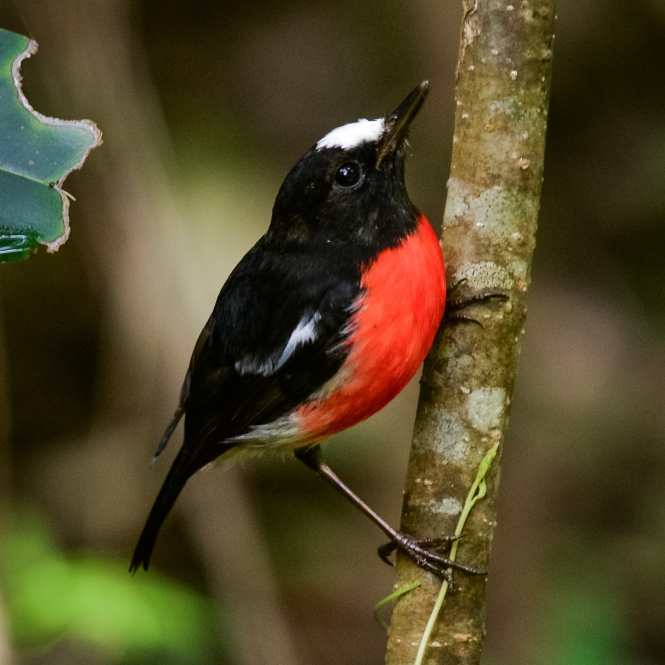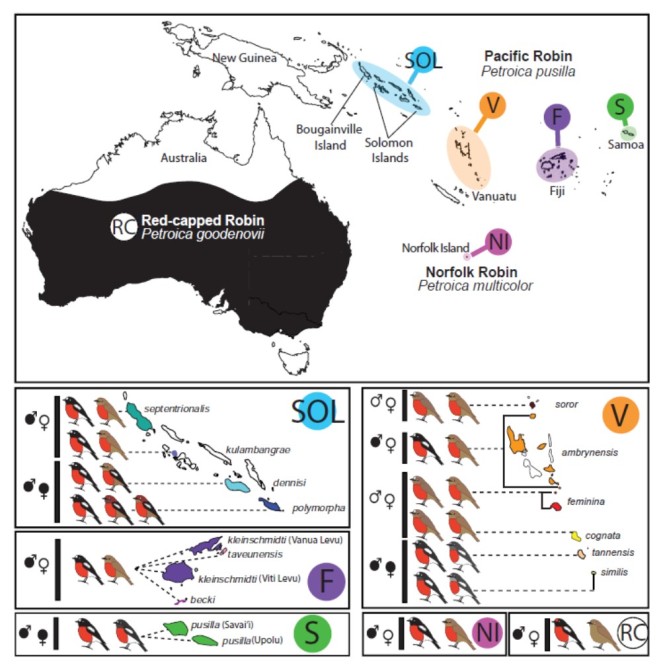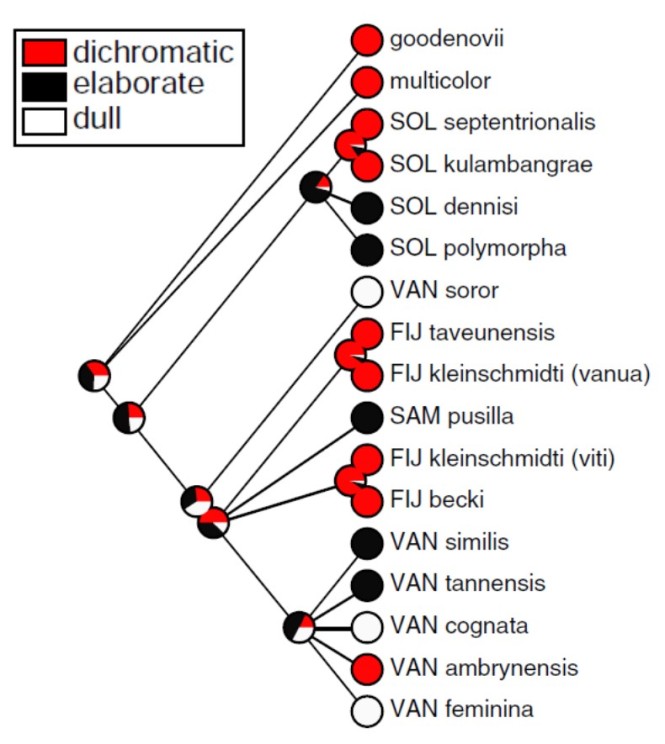A recent study reconstructed the evolutionary history of this island radiation.
Male birds are colorful and female birds are dull. If the plumage colors of males and females are different, you can generally expect this pattern (which biologists refer to as sexually dichromatic). However, several species don’t show these sex-specific differences and it is difficult to tell males and females apart (i.e.they are monochromatic). Especially island species tend to exhibit a reduction in sexual dichromatism. This is nicely exemplified by the the Pacific robin (Petroica multicolor) species complex. The taxa in this complex vary from completely sexually dichromatic to almost monochromatic. Interestingly, some monochromatic taxa have ‘feminine’ dull brown feathers while others have ‘masculine’ black and red plumage patterns. A recent study in the Journal of Avian Biology tried to figure out how this mosaic of sexual plumage coloration evolved.

A Pacific robin (Petroica multicolor) on Norfolk Island © Paul Balfe | Wikimedia Commons
Four Lineages
The Pacific robin species complex contains sixteen distinct taxa, which have been divided into three species. The Norfolk robin (P. multicolor) is endemic to Norfolk Island while the red-capped robin (P. goodenovii) can be found on mainland Australia. The third species (P. pusilla) inhabits several islands, including the Solomon Islands, Vanuatu, Fiji and Samoa (the figure below gives a good overview). As explained above, the taxa in this species complex differ in their sexual plumage patterns. For example, populations on Fiji show clear sexual dichromatism, whereas male and females birds on Somoa are all brightly colored.
Anna Kearns and her colleagues collected samples from each island and reconstructed the evolutionary history of these birds using several genetic markers. They found evidence for four distinct lineages that correspond to particular island groups. There were clear differences between two already recognized species: the Norfolk robin (on Norfolk Island) and the red-capped robin (on Australia). Next, the researchers showed that populations from the Solomon Islands and populations from three other islands (Vanuatu, Fiji and Somoa) diverged about 400,000 years ago and should be considered distinct species.

Distribution and plumage patterns of all taxa within the Pacific robin species complex. Genetic analyses pointed to four distinct lineages: the red-capped robin (RC), the Norfolk robin (NI), the Solomon lineage (SOL) and the VFS-lineage. From: Kearns et al. (2020) Journal of Avian Biology
A Colorful Ancestor
Establishing the phylogenetic framework allowed the researchers to reconstruct the evolutionary history of sexual plumage patterns. The analyses suggested that the ancestor of this species complex was sexually dichromatic and that this trait was lost and regained several times on the Pacific islands. For instance, colorful monochromatism evolved three times independently, on Vanuatu, Samoa and the Solomon Islands.
The exact mechanism behind these evolutionary dynamics remains to be determined. A reduction in sexual dichromatism can be explained by several processes that are not mutually exclusive. First, depending on the environmental conditions, natural selection can drive a population to monochromatism. Second, a relaxation in sexual selection might reduce the selective pressures on colorful males, leading to monochromatism. Third, perhaps a founder effect – where only a subset of a larger population colonizes an island – resulted in the random selection of individuals that happened to be more monochromatic. Fourth, genetic drift in small island populations can lead to the fixation of genes involved in monochromatism. Understanding the genetic basis of these plumage patterns will allow ornithologists to unravel the exciting evolutionary history of these robins in more detail.

The evolution of sexual plumage patterns across the phylogeny of the Pacific robin. The ancestor was probably sexually dichromatic (indicated in red) and this trait was subsequently lost in certain taxa (white = dull monochromatic, black = colorful monochromatic). From: Kearns et al. (2020) Journal of Avian Biology
References
Kearns, A. M., Joseph, L., Austin, J. J., Driskell, A. C., & Omland, K. E. (2020). Complex mosaic of sexual dichromatism and monochromatism in Pacific robins results from both gains and losses of elaborate coloration. Journal of Avian Biology, 51(4).